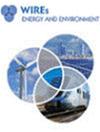Direct evaporative cooling from wetted surfaces: Challenges for a clean air conditioning solution
IF 5.4
3区 工程技术
Q2 ENERGY & FUELS
引用次数: 5
Abstract
Evaporative cooling has a major role to play in fighting climate change and in achieving a low‐carbon economy. As it helps to reduce energy demand for air conditioning, it is gaining attention in terms of improving energy efficiency in buildings. Evaporative cooling from wetted media can enhance water–air contact, thereby improving heat and mass transfer further and avoiding aerosols. Wetted media are commonly called evaporative cooling pads and are widely used in greenhouses, intensive livestock farming, and industrial facilities. However, a deep understanding of evaporative cooling pad performance can enhance their application to indoor occupied spaces such as residential or commercial cooling, or in hybrid air conditioning systems. Most studies analyze pad performance mainly in terms of pressure drop and saturation effectiveness. However, some studies propose alternative cooling efficiency parameters and others provide insights into key aspects such as power requirements and the coefficient of performance, water consumption, risk of water entrainment, material decay, and air quality, as well as the effect of water temperature and salinity, solar radiation, or wind speed. Existing results on these less studied performance issues are reviewed, and we identify the gaps in the literature in addition to highlighting the main challenges encountered, in an effort to guide future researchers in the field and enhance the application of direct evaporative cooling.从潮湿表面直接蒸发冷却:清洁空调解决方案的挑战
蒸发冷却在应对气候变化和实现低碳经济方面发挥着重要作用。由于它有助于减少空调的能源需求,因此在提高建筑能效方面越来越受到关注。湿介质的蒸发冷却可以增强水与空气的接触,从而进一步改善热量和质量传递,避免气溶胶。润湿介质通常被称为蒸发冷却垫,广泛用于温室、集约畜牧业和工业设施。然而,深入了解蒸发冷却垫的性能可以增强其在室内占用空间(如住宅或商业制冷)或混合空调系统中的应用。大多数研究主要根据压降和饱和有效性来分析衬垫性能。然而,一些研究提出了替代的冷却效率参数,而另一些研究则深入了解了关键方面,如功率要求和性能系数、耗水量、夹带水的风险、材料衰变和空气质量,以及水温和盐度、太阳辐射或风速的影响。回顾了这些研究较少的性能问题的现有结果,我们除了强调遇到的主要挑战外,还确定了文献中的空白,以指导该领域的未来研究人员,并加强直接蒸发冷却的应用。
本文章由计算机程序翻译,如有差异,请以英文原文为准。
求助全文
约1分钟内获得全文
求助全文
来源期刊

Wiley Interdisciplinary Reviews-Energy and Environment
ENERGY & FUELS-
CiteScore
11.70
自引率
3.30%
发文量
42
期刊介绍:
Wiley Interdisciplinary Reviews: Energy and Environmentis a new type of review journal covering all aspects of energy technology, security and environmental impact.
Energy is one of the most critical resources for the welfare and prosperity of society. It also causes adverse environmental and societal effects, notably climate change which is the severest global problem in the modern age. Finding satisfactory solutions to the challenges ahead will need a linking of energy technology innovations, security, energy poverty, and environmental and climate impacts. The broad scope of energy issues demands collaboration between different disciplines of science and technology, and strong interaction between engineering, physical and life scientists, economists, sociologists and policy-makers.
 求助内容:
求助内容: 应助结果提醒方式:
应助结果提醒方式:


